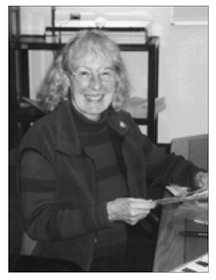Charlene Simpson
Last Updated on March 23, 2024 by Tom Pratum

Charlene Simpson wears many hats: mother and grandmother, community committee person, and avid lay botanist. Her botanical interest dates back to childhood Camp Fire Girl projects and a dad whose motto was always “I brake for wildflowers.” Family and career obligations, however, restricted serious pursuit of botany in her early years. Although born in Colorado, Charlene has lived in Oregon since the age of two. “I know this dates me, but when I moved to Oregon, Eugene’s population was less than 20,000 and what is now the south half of town was farmland.” She points out that this predated the Long Tom, McKenzie, and Willamette River flood control projects. “You don’t know what a wetland really looks like in Eugene, unless you lived then!” she claims. Charlene received her Baccalaur-eate degree in home economics from Oregon State College and her Masters degree in interdisciplinary studies/juvenile corrections from the University of Oregon. She says now that if she had it to do over again, her degrees would be in botany.
Charlene got her first Single Lens Reflex camera in 1975 and purchased a macro lens a year later. From the beginning her fav-orite photographic subjects were wildflowers. She took a com-munity education class in botany at Lane Community College followed by a summer session class at the University of Oregon. She bought Gilkey and Dennis’s Handbook of Northwest Plants, and the Hitchcock Manual and then, as she says, she was hooked.
In 1979 Charlene joined eight others from Eugene and Springfield to found the Emerald Chapter of the Native Plant Society of Oregon (NPSO). David Wagner was the new chapter’s first president and Charlene was its second in 1980-82. She has served the chapter in various other capacities, including secretary, rare and endangered plant chair, and field trip chair. She is a former NPSO director and currently serves on the bulletin mailing committee. Her most recent project was coordination of the Lane County Checklist Project, an effort to list every native or naturalized vascular plant, with site-specific information, in an electronic
data base. Her work on the Lane County Checklist led to becoming a regional coordinator and project leader with the Oregon Atlas Project. Lane County’s project, and the earlier Douglas County Floral Survey are as prototype projects within their respective regions, serving as valuable resources in the development of the Oregon Atlas Project.
Although she doesn’t call herself an environmental activist, Charlene takes citizen involvement seriously. This is borne out by her service on the Lane County Citizen’s Advisory Committee for Management of Roadside Vegetation. She served two three-year terms and was the committee vice chair. The committee worked with public works staff to develop and implement an integrated management program which includes protection for Lane County’s rare and endangered plant species.
Charlene’s large and comprehensive botanical slide collection, with special emphasis on rare and endangered plants, provides a resource for illustrated programs. She has used this medium to educate NPSO members about Lane County’s species of con-cern. Emerald Chapter’s listing format assigns species of concern to three lists according to severity of threat. Charlene enjoys her role in the thick of the biennial reviews, and finds herself drawn to the debates and decisions like a butterfly to a wildflower!
Now retired from the financial aid office of the University of Oregon, Charlene enjoys mid-week field trips and volunteering at the OSU herbarium. She was the organizer and guiding light of Emerald Chapter’s new publication, Vascular Plants of Lane County, Oregon: an Annotated Checklist, which was published inApril 2002. With that major project now completed, Charlene looks forward to travel abroad as well as to more botanical ad-ventures with Veva and Rhoda.
– Rhoda Love, Emerald Chapter.
